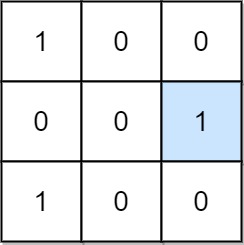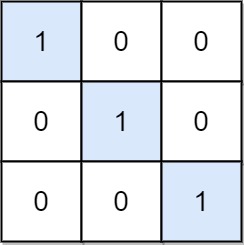- {x}
- Shortest Subarray to be Removed to Make Array Sorted
- Count All Possible Routes
- Replace All ?'s to Avoid Consecutive Repeating Characters
- Number of Ways Where Square of Number Is Equal to Product of Two Numbers
- Minimum Time to Make Rope Colorful
- Remove Max Number of Edges to Keep Graph Fully Traversable
- Put Boxes Into the Warehouse II
- Customer Who Visited but Did Not Make Any Transactions
- Special Positions in a Binary Matrix
- Count Unhappy Friends
- Min Cost to Connect All Points
- Check If String Is Transformable With Substring Sort Operations
- Binary Search Tree Iterator II
- Bank Account Summary II
- Sum of All Odd Length Subarrays
- Maximum Sum Obtained of Any Permutation
- Make Sum Divisible by P
- Read More...

Special Positions in a Binary Matrix
Given an m x n binary matrix mat, return the number of special positions in mat.
A position (i, j) is called special if mat[i][j] == 1 and all other elements in row i and column j are 0 (rows and columns are 0-indexed).
Example 1:

Input: mat = [[1,0,0],[0,0,1],[1,0,0]] Output: 1 Explanation: (1, 2) is a special position because mat[1][2] == 1 and all other elements in row 1 and column 2 are 0.
Example 2:

Input: mat = [[1,0,0],[0,1,0],[0,0,1]] Output: 3 Explanation: (0, 0), (1, 1) and (2, 2) are special positions.
Constraints:
m == mat.lengthn == mat[i].length1 <= m, n <= 100mat[i][j]is either0or1.
Solution Explanation: Counting Special Positions in a Binary Matrix
The problem asks to find the number of "special positions" in a binary matrix. A special position (i, j) is where the element mat[i][j] is 1, and all other elements in the same row (i) and column (j) are 0.
The most efficient approach is a counting method with linear time complexity. Here's a breakdown of the algorithm:
1. Row and Column Sums:
- We initialize two arrays:
rowsto store the sum of elements in each row andcolsto store the sum of elements in each column. - We iterate through the matrix, incrementing
rows[i]andcols[j]for each elementmat[i][j]that is 1. This efficiently counts the number of 1s in each row and column.
2. Identifying Special Positions:
- We iterate through the matrix again.
- For each element
mat[i][j]that is 1, we check two conditions:rows[i] == 1: This verifies that there's only one 1 in the current row.cols[j] == 1: This verifies that there's only one 1 in the current column.
- If both conditions are true, we have found a special position, and we increment our
anscounter.
3. Return the Count:
- Finally, we return the value of
ans, which represents the total number of special positions found.
Time Complexity Analysis:
The algorithm involves two iterations over the matrix. Each iteration takes O(mn) time, where 'm' is the number of rows and 'n' is the number of columns. The other operations (initializing arrays, checking conditions) are linear in the size of the matrix, making them O(m+n). Thus, the overall time complexity is **O(mn)**, which is linear to the size of the input matrix.
Space Complexity Analysis:
The space complexity is determined by the size of the rows and cols arrays. These arrays have sizes 'm' and 'n', respectively. Therefore, the space complexity is O(m+n), which is linear to the dimensions of the matrix.
Code Examples (with explanations):
The code provided in the various programming languages implements this algorithm. They all follow the same structure:
- Initialization: Arrays
rowsandcolsare created and initialized to zero. - Row and Column Summation: The nested loops compute the sum of elements in each row and column.
- Special Position Check: Another nested loop checks for special positions based on the calculated row and column sums.
- Return Value: The final
ansvariable, which keeps count of special positions, is returned.
The comments in the code further clarify each step. The choice of language doesn't significantly impact the algorithmic approach or the complexity analysis. All examples provide the same efficient solution.